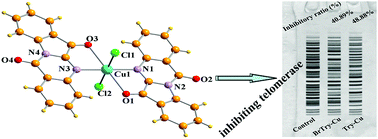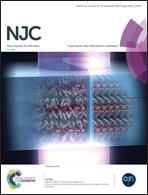Tryptanthrin derivative copper(ii) complexes with high antitumor activity by inhibiting telomerase activity, and inducing mitochondria-mediated apoptosis and S-phase arrest in BEL-7402†
Abstract
The copper(II) complexes of tryptanthrin (Try) and 8-bromo-tryptanthrin (BrTry), [CuII(Try)2Cl2] (Try-Cu) and [CuII(BrTry)2Cl2] (BrTry-Cu), were synthesized and fully characterized by spectroscopic methods and single-crystal X-ray diffraction analysis. The copper(II) centers in the Try-Cu and BrTry-Cu complexes adopted an approximately six-coordinated distorted octahedral geometry. The anticancer activities of Try-Cu and BrTry-Cu were evaluated in vitro against four human cancer cell lines (BEL-7402, T-24, MGC80-3, and HepG2 cells) and one normal human liver cell line (HL-7702 cells). It was found that Try-Cu exhibited selective cytotoxicity against the four selected cancer cells (IC50 = 4.02–9.03 μM) but low cytotoxicity toward the normal human liver HL-7702 cells. Further studies revealed that Try-Cu exhibited its cytotoxic activity mainly by inducing DNA damage and thus causing cell cycle arrest in the S phase, as well as stimulating mitochondrial dysfunction and inhibiting telomerase by interacting with the c-myc promoter.



 Please wait while we load your content...
Please wait while we load your content...